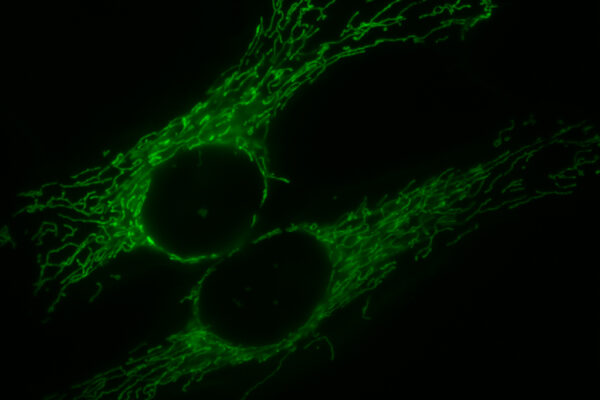Better together: Mitochondrial fusion supports cell division
New research from Gary Patti’s laboratory in Arts & Sciences shows that when cells divide rapidly, their mitochondria are fused together. In this configuration, the cell is able to more efficiently use oxygen for energy. This work illuminates the inner workings of dividing cells and shows how mitochondria combine to help cells to multiply in unexpected ways.
New clues in mice link cholesterol to fertility
Whether made by the body or ingested through diet, cholesterol plays a vital role in cells. Cholesterol also is a building block of steroids and hormones, including those that trigger puberty and support pregnancy. A new study, led by Daniel Ory, MD, implicates a surprising regulator of cholesterol in cells’ ability to make these hormones, especially in tissues associated with fertility, such as the ovaries.
Fatal cell malfunction ID’d in Huntington’s disease
New research from the School of Medicine’s Albert Kim, MD, PhD (left), and Hiroko Yano, PhD, helps explain how mutations in the gene that causes Huntington’s disease kill brain cells. The findings could open new opportunities for treating the fatal disorder.
Possible culprits in congenital heart defects identified
Mitochondria are the power plants of cells, manufacturing fuel so a cell can perform its many tasks, and also are well known for their role in cell death. School of Medicine researchers and colleagues have shown that mitochondria also orchestrate events that determine a cell’s future, at least in the embryonic mouse heart. The study identifies new potential genetic culprits in the origins of some congenital heart defects. Shown is an image of a normal heart.
Tumors disable immune cells by using up sugar
Cancer cells’ appetite for sugar may have serious consequences for immune cell function. Scientists have shown that in low-sugar environments immune T cells start using energy-making structures known as mitochondria (highlighted in this image in yellow and orange). This switch can prevent T cells from making
an inflammatory compound important for fighting cancers and some
infections.
Missing link in Parkinson’s disease found
School of Medicine researchers have described a missing link in understanding how damage to the body’s cellular power plants leads to Parkinson’s disease and some forms of heart failure. A mouse heart, in gray, shows signs of heart failure because it is missing a newly discovered key molecule in the process that culls unhealthy mitochondria from cells. Superimposed on the heart is a fruit fly heart tube, shown in color. It shows signs of failure because it is missing another key molecule in mitochondrial quality control.
New clues to causes of peripheral nerve damage
Although peripheral neuropathies afflict some 20 million Americans, their underlying causes are not completely understood. Now, scientists have shown that damage to energy factories in Schwann cells, which grow alongside neurons and enable nerve signals to travel from the spinal cord to the tips of the fingers and toes, may play a central role. Shown is a Schwann cell surrounding nerve axons, shown in green.
Immune system memory cells have trick for self preservation
After defeating an infection, the immune system creates a memory of the attacker to make it easier to eliminate in the future. Researchers at Washington University School of Medicine in St. Louis have discovered an important component of the immune system’s strategy for preserving such immunological memories.

